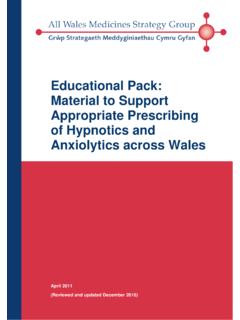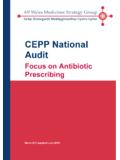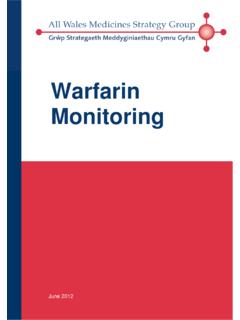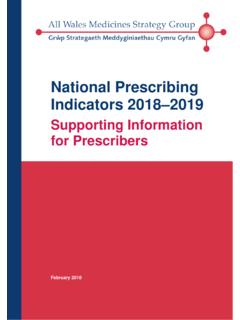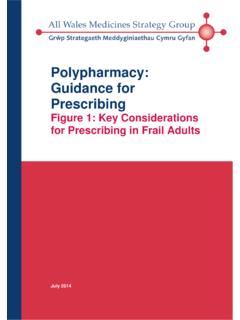Transcription of All Wales Prescription Writing Standards - AWMSG
1 1 All Wales Prescription Writing Standards These Standards should be read in conjunction with completing the All Wales Medication Chart e- learning package, available on the Learning@NHSW ales internet site ( ). Instructions to access may be found at They are based on national guidelines and legislation, Section 1 : General Requirements These apply to ALL prescriptions including in-patient charts, outpatient and take home prescriptions; and to any communications to General Practitioners regarding medication All prescriptions must be written: CLEARLY LEGIBLY INDELIBLY Out-patient and Take Home Prescription forms should have only one item written on each line and additional Prescription forms used if necessary.
2 Any unused space on the Prescription form should be deleted manually Patient Identification & Details The patient s full name, address, date of birth and hospital number must appear on all prescriptions. Age and weight must be stated on all paediatric (under 12 years) prescriptions. Drug Name The international approved drug name (rINN) must be printed in clearly, legibly and indelibly so that each individual letter can be read. Do not use chemical descriptions or abbreviations for drug names as they increase the risk of medication errors ( FeSO4, ISMN are not acceptable) The bioavailability of some medications may vary between different brands, and should be prescribed by brand name; these drugs include: Anti-epileptics (as per MHRA advice) Ciclosporin Diltiazem long acting formulations Lithium Mycophenolate Nifedipine Theophylline modified release Tacrolimus NB This list is not exhaustive.
3 It will sometimes be appropriate to use the brand name, in addition to or instead of the approved name, for other medicines to avoid confusion (examples include insulin, some combination products and opioids with particular emphasis on transdermal preparations). Formulation / Strength Where different formulations and/or strengths of a preparation are available, it is important that details are correctly stated on the Prescription modified release vs. immediate release tablets/capsules; transdermal opioid preparations. 2 Device It is important to state the device required for medication such as insulin and inhalers to ensure the patient receives the correct product.
4 Drug Dose The dose must be stated on all prescriptions Avoid unnecessary use of decimal points. 3mg (not ) Quantities of 1 gram or more must be written as 1g etc. Quantities less than 1 gram must be written in milligrams 500mg (not ) Quantities less than 1 milligram must be written in micrograms 100micrograms (not ) When decimal points are unavoidable, a zero must be put in front of the decimal point where there is no other figure (not .5ml) Micrograms, nanograms and units must be written in full and not abbreviated g (grams), mL(millilitres), and mg (milligrams) are acceptable abbreviations Doses of liquid preparation MUST be written as mg etc unless there is no equivalent.
5 The concentration of liquid preparations must always be stated ( Furosemide 20mg in 5ml, 40mg in 5ml or 50mg in 5ml). This is particularly important when prescribing for children. Be aware that there may be unlicensed preparations available in different strengths Phenytoin Route Specify the route of administration. Take care when prescribing for different routes as doses may not be equivalent, in which case separate prescriptions for each route must be written. ( The intravenous dose of Morphine is one quarter to one half of the intramuscular dose, therefore separate prescriptions are required) Acceptable abbreviations are: IV intravenous IM intramuscular SC subcutaneous PO / O oral NG nasogastric PEG via peg tube JEJ via jejunostomy tube S/L sublingual PR rectal PV vaginal Top topical INH inhaled NEB nebulised BE both eyes LE left eye RE right eye Directions The dosage frequency must be stated on all prescriptions.
6 For as required medications, a minimum dose interval must be specified, and where appropriate a maximum dose ( Paracetamol 500mg tablets, one to two tablets every four to six hours when required, maximum 8 tablets in 24 hours, for the relief of pain or fever) The indication for any as required medication should also be Directions should be in English without abbreviation; however the following Latin abbreviations are acceptable: daily or mane in the morning twice daily or nocte at night three times daily stat immediately four times daily when required 3 Where a limited course of treatment is required ( steroids, antibiotics) this must be stated on the Prescription .
7 Particular care must be taken when prescribing medication to be taken weekly, monthly etc. It is good practice to cross through the administration boxes on the In-patient chart to emphasise that the dose must only be administered on certain days. When a drug is only administered monthly or 3 monthly, it is good practice to record when the last dose was given to ensure an accurate medicines trail. Prescriber s Signature & Date All prescriptions must be signed and dated by the prescriber with a bleep number or contact details supplied. Non-medical prescribers must annotate their signatures appropriately.
8 ---------------------------------------- ---------------------------------------- -------------------------------- Section 2: Requirements for Prescribing and Recording Administration on the All Wales In-patient Medication Record charts In addition to the above Standards , the following apply to the All Wales Acute and Long Stay and Paediatric In-patient Medication Record charts. A new chart must be written for each admission, and the chart discontinued (by crossing through the front page) when the patient is discharged. (Local policies may allow for the continued use of the chart for weekend leaves and respite care) Charts that are no longer in use ( administration record is full) must be crossed through; signed and dated ensuring information on the chart is not obscured.
9 Patient s name and health record number must be stated on each page of the chart to reduce the risk of prescribing and administration error. Allergy box This section must be completed, signed and dated prior to administration of medicines. When an allergy is recorded, document as much information as possible regarding the details of allergy or reaction. Medication should not be administered if this section is not completed refer back to the prescriber immediately to avoid doses being delayed or omitted. In exceptional circumstances, if unable to ascertain allergy status, this must be documented, signed and dated in the allergy box and the medical notes.
10 Remember to update the box should any new reactions occur. Hospital / ward / consultant Details must be completed and kept up to date when changes are made. Weight / Height / Body surface area Current weight must be stated on all paediatric charts. Current weight should be included on adult charts when it is appropriate for medication dosage; low molecular weight heparins, IV paracetamol. Height should be stated when body surface area is used to calculate dosage. 4 Supplementary charts & multiple medication charts Use these sections to record other medication charts in use.




